#mario mannucci
Explore tagged Tumblr posts
Text

Sandro Munari & Mario Mannucci - Lancia Fulvia 1.6 Coupé HF Lancia Marlboro Team - Rallye de Monte-Carlo 1973. - source Moto Vitelloni - Wheels n' wings.
44 notes
·
View notes
Text



Sandro Munari 🇮🇹Mario Mannucci 🇮🇹#2.Lancia Stratos HF.Lancia Malboro.Assistance.Vainqueurs 🏆🏆.Rallye de Sanremo 🇮🇹1974
69 notes
·
View notes
Text

Princess Grace and Prince Rainier of Monaco presenting the Rallye Monte-Carlo trophy to Sandro Munari and Mario Mannucci, January 27, 1975, Monaco.
2 notes
·
View notes
Text
1 note
·
View note
Photo

Image from the exhibition No Comment, Montevarchi, Italia, Mannucci Casa (July-August 2 019, ended ten days ago) © Mario Mannucci :
#mario mannucci#art#emotions#italian photographers#perfections#flowers#nature#artists on tumblr#photographers on tumblr#masterpieces#masters on tumblr#composition#digital art#yes we are magazine#gifts#magic#less is more#icm#selective color#compo science#submission
21 notes
·
View notes
Text
La storia di Mario Mannucci, il maestro delle note
La storia di Mario Mannucci, il maestro delle note
Non c’è una ricorrenza precisa per cui ti racconto la storia di Mario Mannucci e, in realtà, non ce n’è bisogno. Mario, che è andato via il 17 dicembre 2011, ha costruito la ‘Leggenda Lancia’. A tutti gli effetti è un UomoLancia. Era navigatore del Drago, Sandro Munari, con il quale ha dominato le competizioni con la Lancia. Aveva 79 anni e, come lo ricorda il suo amico Carlo Cavicchi, ex…
View On WordPress
#aggiornamenti rally#aneddoti rally#campionato del mondo rally#lancia fulvia hf#libri di rally#maestro delle note#mario mannucci#mondiale rally#munari-mannucci#news wrc#notizie rally#notte dei lunghi coltelli#racing cars#rally book#rally montecarlo 1972#rally montercalo#rally story#sandro munari#storia dei rally#storie copiloti rally#storie di rally#storie piloti rally#vetture rally#world rally championship
1 note
·
View note
Photo
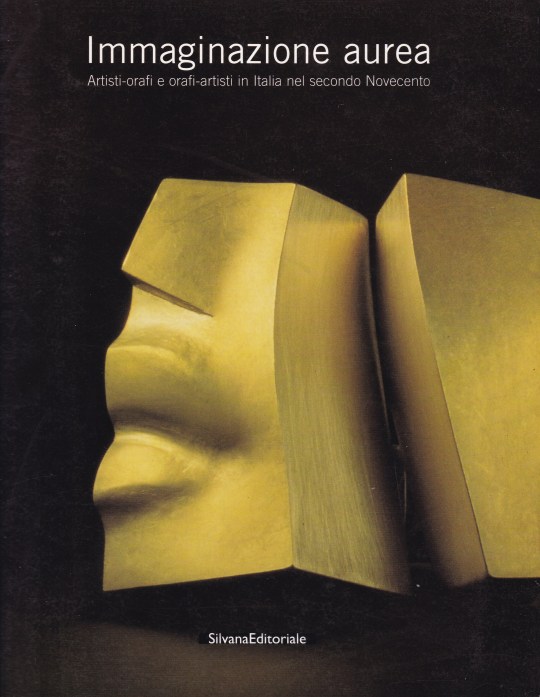


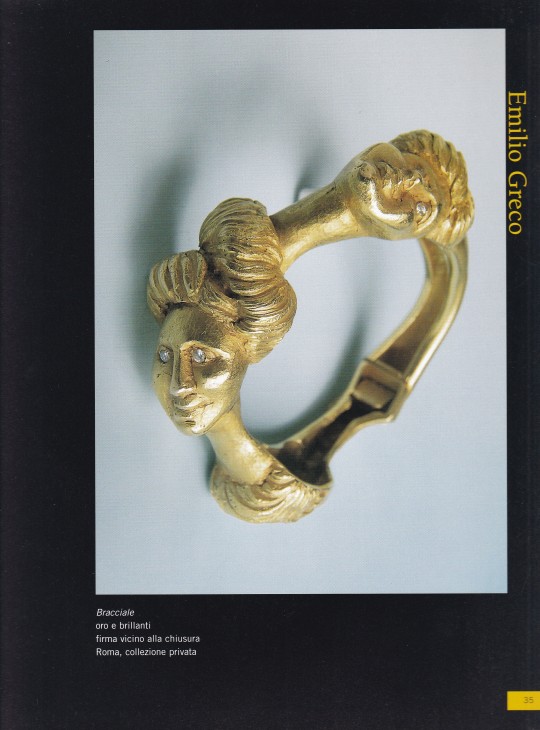
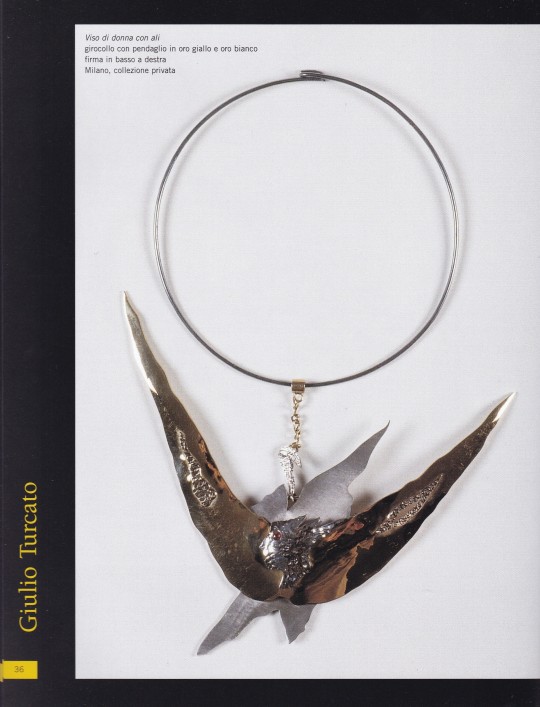
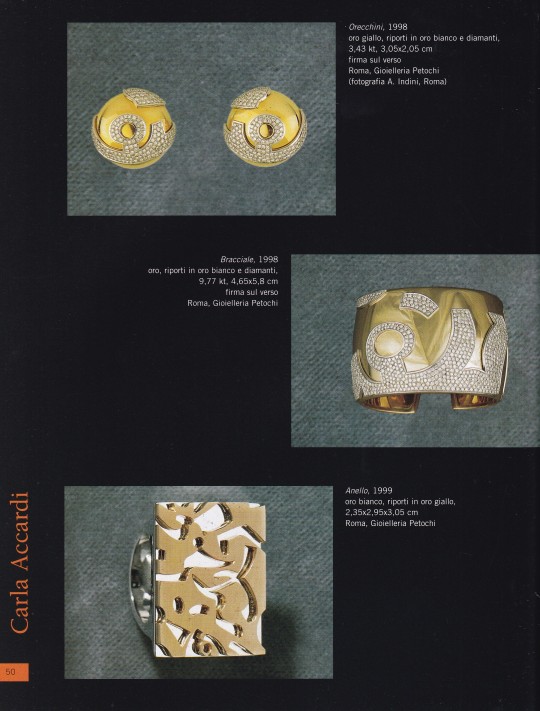
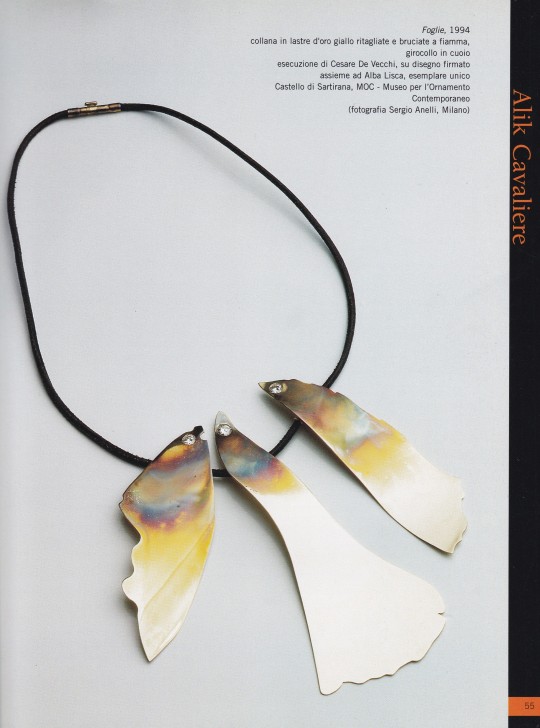

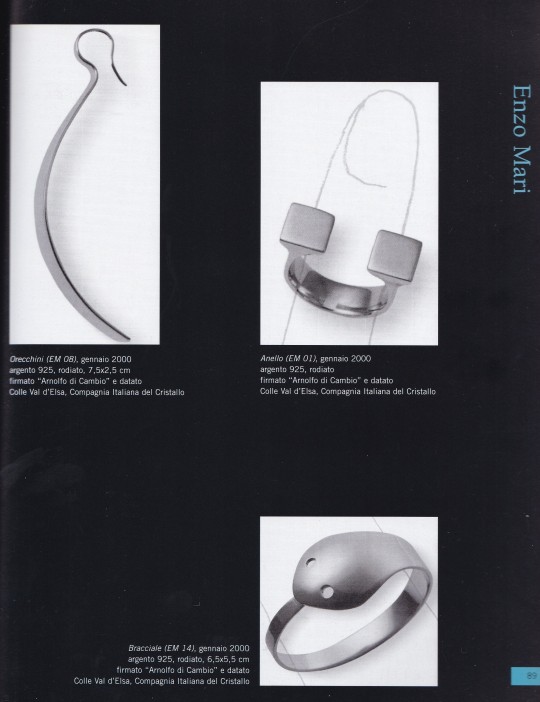
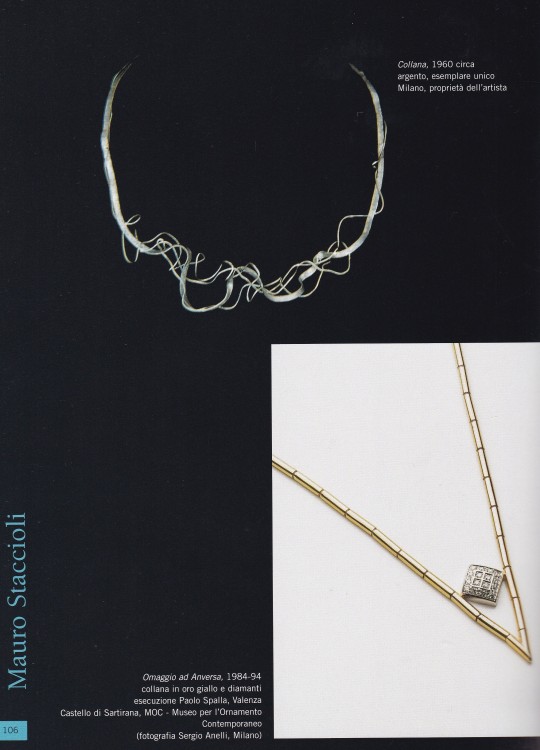
Immaginazione aurea
Artisti-orafi e orafi-artisti in Italia nel secondo Novecento
Catalogo a cura di Enrico Crispolti
SilvanaEditoriale, Cinisello Balsamo 2001,176 pagine, 300 ill.colori, 23x28 cm., ISBN 9788882153014
euro 30,00
email if you want to buy [email protected]
Mostra Ancona - Mole Vanvitelliana 21 aprile - 29 luglio 2001
Opere di: Carla Accardi, Afro, Getulio Alviani, Mario Ballocco, Renato Barisani, Aldo Calò, Carmelo Cappello, Eugenio Carmi, Pietro Cascella, Alik Cavaliere, Mario Ceroli, Bruno Ceccobelli, Riccardo Dalisi, Lucio Fontana, Omar Galliani, Lorenzo Guerrini, Edgardo Mannucci, Eliseo Mattiacci, Fausto Melotti, Bruno Munari, Arnaldo Pomodoro, Giò Pomodoro, Mimmo Rotella, Emilio Scanavino, Ettore Sottsass jr., Daniel Spoerri, Mauro Staccioli, Vladimiro Tulli, Giulio Turcato, Giuseppe Uncini, Luigi Veronesi e molti altri.
Attraverso la ricostruzione dell'attività dell'oreficeria italiana nella seconda metà del XX secolo, il volume mira a rompere l'usuale schema bipartito di artisti-orafi e orafi-artisti, istituendo un confronto aperto e paritetico tra le opere d'oreficeria realizzate da artisti plastici oppure da artigiani orafi. I più interessanti maestri della scultura contemporanea e dell'oreficeria in Italia, presentano le forme loro suggerite dall'immaginazione e dalla fantasia, nelle prezione materie dell'oro e dell'argento. Nel lavoro sull'oro (ma in realtà è in gioco una vasta gamma di materiali), ciascuno riversa le proprie esperienze e le proprie sperimentazioni: per l'artista l'impegno nell'oreficeria non è mai un trasferimento di ricerche già elaborate, ma l'occasione di una nuova e affascinante avventura espressiva; per l'orafo si tratta di portare intenzionalmente la propria realizzazione a un livello di elaborazione di valenza anche plastica.
02/06/22
orders to: [email protected]
ordini a: [email protected]
twitter: @fashionbooksmi
instagram: fashionbooksmilano, designbooksmilano tumblr: fashionbooksmilano, designbooksmilano
#Immaginazione aurea#artisti-orafi#orafi-artisti#Enzo Mari#Bruno Munari#Ettore Sottsass#Giò Pomodoro#Lucio Fontana#Fausto Melotti#Carla Accardi#Alik Cavaliere#Mimmo Rotella#oreficeria#gioielleria#art exhibition catalogue#mostra Mole Vanvitelliana Ancona 2001#jewelry books#fashionbooksmilano
25 notes
·
View notes
Text
Mostra Antologica di Paolo Gubinelli “Segni, graffi e colore” (Carte, ceramiche, vetri e progetti in plexiglass) Opere dal 1977- 2021 a cura di Sandro Bongiani 11 dicembre 2021 - 13 febbraio 2022 Via S. Calenda 105/D, 84126 SALERNO (Italy). http://www.collezionebongianiartmuseum.it

Paolo Gubinelli
Biografia
Nato a Matelica (MC) nel 1945, vive e lavora a Firenze. Si diploma presso l’Istituto d’arte di Macerata, sezione pittura, continua gli studi a Milano, Roma e Firenze come grafico pubblicitario, designer e progettista in architettura. Giovanissimo scopre l’importanza del concetto spaziale di Lucio Fontana che determina un orientamento costante nella sua ricerca: conosce e stabilisce un’intesa di idee con gli artisti e architetti: Giovanni Michelucci, Bruno Munari, Ugo La Pietra, Agostino Bonalumi, Alberto Burri, Enrico Castellani, Piero Dorazio, Emilio Isgrò, Umberto Peschi, Edgardo Mannucci, Mario Nigro, Emilio Scanavino, Sol Lewitt, Giuseppe Uncini, Zoren.
Partecipa a numerose mostre personali e collettive in Italia e all’estero.
Le sue opere sono esposte in permanenza nei maggiori musei in Italia e all’estero.
Nel 2011 ospitato alla 54 Biennale di Venezia Padiglione Italia presso L’Arsenale invitato da Vittorio Sgarbi e scelto da Tonino Guerra, installazione di n. 28 carte cm. 102x72 accompagnate da un manoscritto inedito di Tonino Guerra.
Sono stati pubblicati cataloghi e riviste specializzate, con testi di noti critici:
Giulio Carlo Argan, Giovanni Maria Accame, Cristina Acidini, Mariano Apa, Mirella Bandini, Carlo Belloli, Paolo Bolpagni, Mirella Branca, Vanni Bramanti, Anna Brancolini, Carmine Benincasa, Luciano Caramel, Ornella Casazza, Claudio Cerritelli, Bruno Corà, Roberto Cresti, Giorgio Cortenova, Enrico Crispolti, Fabrizio D’Amico, Roberto Daolio, Angelo Dragone, Luigi Paolo Finizio, Alberto Fiz, Paolo Fossati, Carlo Franza, Francesco Gallo, Roberto Luciani, Mario Luzi, Marco Marchi, Luciano Marziano, Lara Vinca Masini, Marco Meneguzzo, Fernando Miglietta, Bruno Munari, Antonio Paolucci, Sandro Parmiggiani, Elena Pontiggia, Pierre Restany, Davide Rondoni, Maria Luisa Spaziani, Carmelo Strano, Claudio Strinati, Toni Toniato, Tommaso Trini, Marcello Venturoli, Stefano Verdino, Cesare Vivaldi.
Sono stati pubblicati cataloghi di poesie inedite dei maggiori poeti Italiani e stranieri:
Adonis, Alberto Bertoni, Alberto Bevilacqua, Libero Bigiaretti, Franco Buffoni, Anna Buoninsegni, Enrico Capodaglio, Alberto Caramella, Roberto Carifi, Ennio Cavalli, Antonio Colinas, Giuseppe Conte, Vittorio Cozzoli, Maurizio Cucchi, Milo De Angelis, Eugenio De Signoribus, Gianni D’Elia, Luciano Erba, Giorgio Garufi, Tony Harrison, Tonino Guerra, Emilio Isgrò, Clara Janés, Ko Un, Vivian Lamarque, Franco Loi, Mario Luzi, Giancarlo Majorino, Alda Merini, Alessandro Moscè, Roberto Mussapi, Giampiero Neri, Nico Orengo, Alessandro Parronchi, Feliciano Paoli, Titos Patrikios, Umberto Piersanti, Antonio Riccardi, Davide Rondoni, Tiziano Rossi, Roberto Roversi, Paolo Ruffilli, Mario Santagostini, Antonio Santori, Frencesco Scarabicchi, Fabio Scotto, Michele Sovente, Maria Luisa Spaziani, Enrico Testa, Paolo Valesio, Cesare Vivaldi, Andrea Zanzotto.
Stralci critici:
Giulio Angelucci, Biancastella Antonino, Flavio Bellocchio, Goffredo Binni, Sandro Bongiani, Fabio Corvatta, Nevia Pizzul Capello, Claudio Di Benedetto, Debora Ferrari, Antonia Ida Fontana, Franco Foschi, Mario Giannella, Armando Ginesi, Claudia Giuliani, Vittorio Livi, Olivia Leopardi Di San Leopardo, Luciano Lepri, Caterina Mambrini, Elverio Maurizi, Carlo Melloni, Eugenio Miccini, Franco Neri, Franco Patruno, Roberto Pinto, Anton Carlo Ponti, Osvaldo Rossi, Giuliano Serafini, Patrizia Serra, Maria Luisa Spaziani, Maria Grazia Torri, Francesco Vincitorio.
Nella sua attività artistica è andato molto presto maturando, dopo esperienze pittoriche su tela o con materiali e metodi di esecuzione non tradizionali, un vivo interesse per la “carta”, sentita come mezzo più congeniale di espressione artistica: in una prima fase opera su cartoncino bianco, morbido al tatto, con una particolare ricettività alla luce, lo incide con una lama, secondo strutture geometriche che sensibilizza al gioco della luce piegandola manualmente lungo le incisioni.
In un secondo momento, sostituisce al cartoncino bianco, la carta trasparente, sempre incisa e piegata; o in fogli, che vengono disposti nell’ambiente in progressione ritmico-dinamica, o in rotoli che si svolgono come papiri su cui le lievissime incisioni ai limiti della percezione diventano i segni di una poesia non verbale.
Nella più recente esperienza artistica, sempre su carta trasparente, il segno geometrico, con il rigore costruttivo, viene abbandonato per una espressione più libera che traduce, attraverso l’uso di pastelli colorati e incisioni appena avvertibili, il libero imprevedibile moto della coscienza, in una interpretazione tutta lirico musicale. Oggi questo linguaggio si arricchisce sulla carta di toni e di gesti acquerellati acquistando una più intima densità di significati.
Ha eseguito opere su carta, libri d’artista, su tela, ceramica, plexiglass, vetro con segni incisi e in rilievo in uno spazio lirico-poetico.
Eng
Paolo Gubinelli, biography.
Born in Matelica (province of Macerata) in 1945, lives and works in Florence. He received his diploma in painting from the Art Institute of Macerata and continued his studies in Milan, Rome and Florence as advertising graphic artist, planner and architectural designer. While still very young, he discovered the importance of Lucio Fontana’s concept of space which would become a constant in his development: he became friends with such artists as :
Giovanni Michelucci, Bruno Munari, Agostino Bonalumi, Alberto Burri, Enrico Castellani, Piero Dorazio, Emilio Isgrò, Ugo La Pietra, Umberto Peschi, Emilio Scanavino, Edgardo Mannucci, Mario Nigro, Sol Lewitt, Giuseppe Uncini, and Zoren, and established a communion of ideas and work.
His work has been discussed in various catalogues and specialized reviews by such prominent critics as:
Many others have also written about his work:
Giulio Carlo Argan, Giovanni Maria Accame, Cristina Acidini, Mariano Apa, Mirella Bandini, Carlo Belloli, Paolo Bolpagni, Mirella Branca, Vanni Bramanti, Anna Brancolini, Carmine Benincasa, Luciano Caramel, Ornella Casazza, Claudio Cerritelli, Bruno Corà, Roberto Cresti, Giorgio Cortenova, Enrico Crispolti, Fabrizio D’Amico, Roberto Daolio, Angelo Dragone, Luigi Paolo Finizio, Alberto Fiz, Paolo Fossati, Carlo Franza, Francesco Gallo, Roberto Luciani, Mario Luzi, Marco Marchi, Luciano Marziano, Lara Vinca Masini, Marco Meneguzzo, Fernando Miglietta, Bruno Munari, Antonio Paolucci, Sandro Parmiggiani, Elena Pontiggia, Pierre Restany, Davide Rondoni, Maria Luisa Spaziani, Carmelo Strano, Claudio Strinati, Toni Toniato, Tommaso Trini, Marcello Venturoli, Stefano Verdino, Cesare Vivaldi.
His works have also appeared as an integral part of books of previously unpublished poems by major Italian poets foreigners:
Adonis, Alberto Bertoni, Alberto Bevilacqua, Libero Bigiaretti, Franco Buffoni, Anna Buoninsegni, Enrico Capodoglio, Alberto Caramella, Ennio Cavalli, Antonio Colinas, Giuseppe Conte, Vittorio Cozzoli, Maurizio Cucchi, Milo De Angelis, Eugenio De Signoribus, Gianni D’Elia, Luciano Erba, Giorgio Garufi, Tony Harrison, Tonino Guerra, Emilio Isgrò, Clara Janés, Ko Un, Vivian Lamarque, Franco Loi, Roberto Luciani, Mario Luzi, Giancarlo Majorino, Alda Merini, Alessandro Moscè, Roberto Mussapi, Giampiero Neri, Nico Orengo, Ko Un, Alessandro Parronchi, Feliciano Paoli, Titos Patrikios, Umberto Piersanti, Antonio Riccardi, Davide Rondoni, Tiziano Rossi, Roberto Roversi, Paolo Ruffilli, Mario Santagostini, Antonio Santori, Frencesco Scarabicchi, Fabio Scotto, Michele Sovente, Maria Luisa Spaziani, Enrico Testa, Paolo Valesio, Cesare Vivaldi, Andrea Zanzotto.
CRITICAL EXCERPTS:
Giulio Angelucci, Biancastella Antonino, Flavio Bellocchio, Goffredo Binni, Sandro Bongiani, Fabio Corvatta, Nevia Pizzul Capello, Claudio Di Benedetto, Debora Ferrari, Antonia Ida Fontana, Franco Foschi, Mario Giannella, Armando Ginesi, Claudia Giuliani, Vittorio Livi, Olivia Leopardi Di San Leopardo, Luciano Lepri, Caterina Mambrini, Elverio Maurizi, Carlo Melloni, Eugenio Miccini, Franco Neri, Franco Patruno, Roberto Pinto, Anton Carlo Ponti, Osvaldo Rossi, Giuliano Serafini, Patrizia Serra, Maria Luisa Spaziani, Maria Grazia Torri, Francesco Vincitorio.
He participated in numerous personal and collective exhibitions in Italy and abroad. Following pictorial experiences on canvas or using untraditional materials and techniques, he soon matured a strong interest in “paper” which he felt the most congenial means of artistic expression. During this initial phase, he used a thin white cardboard, soft to the touch and particularly receptive to light, whose surface he cut with a blade according to geometric structures to accent the play of light and space, and then manually folded it along the cuts.
In his second phase, he substituted thin white cardboard with the transparent paper used by architects, still cutting and folding it, or with sheets arranged in a room in a rhythmic-dynamic progression, or with rolls unfurled like papyruses on which the very slight cuts challenging perception became the signs of non-verbal poetry.
In his most recent artistic experience, still on transparent paper, the geometric sign with its constructive rigor is abandoned for a freer expression which, through the use of colored pastels and barely perceptible cuts, translates the free, unpredictable motion of consciousness in a lyrical-musical interpretation.
Today, he expresses this language on paper with watercolor tones and gestures which lend it a greater and more significant intensity.
He made white and colour pottery where engraved and relief signs stand out in a lyrical-poetic space.
- Le opere su vetro realizzate per Fiam Italia Pesaro, esposte nella collezione a Villa Miralfiore
- Le opere su ceramica realizzate: Ceramiche Biagioli Gubbio, Ceramiche Bizzirri, Città di Castello
1 note
·
View note
Photo




Lancia Fulvia HF. -source FCA Heritage.
Sandro Munari & Mario Mannucci vainqueur du Rallye Monte-Carlo 1972
108 notes
·
View notes
Text
SAIL 2017 - BUFEO BLANCO, THE WINNER CLASSIC YACHT 2017

10 maggio 2017 - Blanco is one of the most well known classic sailing yachts of the Mediterranean, winner of many classic yachts races. Long 15,50 mt, it was built in 1963 with mahogany and durmast wood by the famous Ligurian Shipyard Sangermani of Lavagna. During the last decade, Bufeo has sailed for more than 50.000 nautical miles all over the Mediterranean, from Turkey to Spain, from Greece many times to Croatia, from Cote d'Azur to Trieste, crossing over Sardinia and Sicily. She is looking for a new owner, why? Better read the article. Bufeo Blanco, the white dolphin of the Amazon Bufeo Blanco is one of the most well known classic sailing yachts of the Mediterranean, protagonist of many navigations and winner of the most prestigious international classic yacht races. This strong bermudian cutter long 15,50 mt, entirely built in wood in 1963 by the famous Ligurian Shipyard Sangermani of Lavagna (project number 138), during the last decade has sailed for more than 50.000 nautical miles. Bufeo Blanco is the name of a white dolphin of the Amazon and in the Peruvian tradition brings luck to those who could see him. The writer Mario Vargas Llosa, in the book “Pantaleòn and the Visitors” describes the Bufeo Blanco as an animal pf an incredible sexual power, which fat invigorates the men and make them more prolific. Bufeo Blanco has sailed all over Italian coasts to Spain, from Turkey to Peloponnesus, from Sicily to North Adriatic Sea, from Croatia to France, giving demonstration of being able to afford any meteo condition. Today the boat is based between Liguria and Tuscany, Italian flag with the burgee of the Reale Yacht Club Canottieri Savoia (Naples) and of the Royal Ocean Racing Club (London), it is member of the prestigious Monegasque "Belle Classe", the Club which welcomes the most beautiful and noble classic sailing yacht still navigating. Five owners since the birth As of 1963 Bufeo Blanco has had five owners. The boat was ordered by the entrepeneur Sergio Rossi, owner of the Comau Automotive in Turin. At that time the name was Luima, like the the son and daughter of Mr Rossi, Luigi and Maria. The base was in Cote d'Azur. From 1973 to 1983, the entrepreneur Luigi Botto Steglia took her. He decided to change the name into Bufeo Blanco. From 1983 and 1992, this bermudian cutter has navigated under the ownership of the Milanese designer Ido Minola who sailed in the Mediterranean up to Greece. From 1992 and 2006, the yacht had a new owner, the notary Luigi Oneto of Alessandria. This is the time of participation at the international meetings of classic yachts, like the Prada Trophy of Imperia. Luigi Oneto is well known as sailor on board of Dinghy 12 class. During that period the direct challenger of Bufeo Blanco is Artica II, the bermudian yawl lenght 12,56 mt built by the same Shipyard Sangermani of Lavagna upon instruction of the ItaIian Navy as a training sailing ship. In 2006 Bufeo Blanco was bought by Professor Giuseppe Marino([email protected]). The History of a youth passion In 1992, when he was 27, Giuseppe Marino used to journey in Salina, a small island of the Eolie arcipelagus, Sicily, where Luigi Oneto began his professional career. Families are friends together. The year before Oneto, on his way back from a sailing cruise in Malta, acquired Bufeo Blanco in Catania. In that period, Giuseppe Marino participated to the transfer of the boat to Genoa Sestri Ponente for a complete refitting. At the same time, Oneto conducted an historical research in Cote d'Azur, where the boat used to sail between Villefranche-sur-Mer and Monaco, in order to find the original pieces of Bufeo Blanco. The original winches were found in a Shipyard in Monaco, together with the bell, the still admiralty anchor and the boat hook. Always in 1992, after the refitting in Liguria, Bufeo Blanco sailed to Salina. There was no Marina at that time, so the boat was moored at buoy in front of the commercial port. She was so beautiful that the entire Salina community adopted her. In the same time, Giuseppe Marino, after a degree in business administration at Bocconi University and in law at the University of Milan, was researcher of international tax law in the Netherlands. Nothing impeded to think at Bufeo Blanco as the boat of his dreams. And the dreams often may come true. From Sicily to the Del Carlo Shipyard of Viareggio, "Cecco" says yes! During the summer 2016 Giuseppe Marino arrives in Salina but Bufeo Blanco is not there. She is in the Marina of Portorosa, nearby Milazzo, for maintenance. Notary Luigi Oneto wishes to sell the boat to the young lawyer who accepts upon the condition that wood hull is in a good shape. In the month of September Giuseppe Marino and his wife Francesca visit the Imperia meeting of classic yachts, where they meet Vieri Mannucci Benincasa, master sailor former member of the Prada team who was already involved into the refitting of Danae, another Sangermani of 1955, long 16,50 mt. A crew member of Danae, Achille Bontà, says to Giuseppe: "remember, the boat is a complex system living in a hostile environment. Everything you put inside will break, the less you have the less you break". The message hits Giuseppe who takes as a mission to restore Bufeo Blanco as she was built. At the end of September 2006, Bufeo Blanco leaves Sicily having Giuseppe Marino, his father and Vieri Mannucci on board with a great "parmigiana di melanzane", and after Vibo Valentia, Marina di Camerota, Capri, Riva di Traiano, Cala Galera, the arrival in Viareggio at the Del Carlo Shipyard. Here "Cecco", the founder in 1963 of a great reality specialized in the refitting of wooden yachts, takes his penknife and tucks it into several points of the hull, and then says, "the boat is good!". Now the dream comes true, the adventure may start. The refitting and the participation to classic yachts regattas At the Del Carlo Shipyard, under the direction of Vieri Mannucci Benincasa, the refitting of Bufeo Blanco is initiated. The interiors are philologically restored, the hydraulic, electric and electronic plant are totally renewed, a generator, a water machine and an air conditioning system are on board for the first time. The old engine Yanmar 55 hp is substituted with a Volvo Penta 75 hp. The works go further from November 2006 until June 2007. Since then, a very long list of destinations, which demonstrate the good quality construction and refitting of this bermudian cutter. That year Bufeo Blanco participates at the Argentario Sailing Week in Porto Santo Stefano, where with a set of old sails and a friends and family crew, reaches the third position after Swala and Artica II. Then a long navigation down to Salina where she receives a warm welcome back home. After summer time, up to Cannes for the Regates Royales, with the strongest hail in the history of the regatta. The infinite cruises Since 2008 Bufeo Blanco is based in Le Grazie, a cute and safe harbor in the gulf of La Spezia. During the decade, Bufeo participates to many regattas, in back at the Argentario Sailing Week, the Classic Week in Naples, then a beautiful cruise in the Ionian islands of Greece, once back in Le Grazie she participates at the meeting Sulla Rotta di Imperia (which shall be renamed Valdettaro Classic Boats). In 2009, after 60 knots in Elba Island at the Marina di Campo (20th June 2009), again the Classic Week in Naples and then all the Sicilian islands, from Eolie to Egadi and back to Le Grazie. In 2010, a young and trustworthy navigator enters in the life of Bufeo Blanco and the Marinos Family, Marco Buonanni, a neapolitan former Navy officer who sails for thousands miles. This is the time when Bufeo Blanco crosses the Corinth Canal with destinations the Sporades, with step in Cape Sounion, Khalkis, Skiathos, Skopelos (where the movie "Mamma Mia" has been played), Alonissos, and Skyros. In 2011 the destination is Spain, via Marseille and Golfe du Lion, to participate at the Puig Vela Clasica Trophy in Barcelona, then Baleares Ibiza, Formentera, Maiorca and Minorca where she participates at the Copa del Rey Clasica Panerai regatta. In October the victory of the Vele Storiche Viareggio. 50.000 nautical miles In 2012 Bufeo Blanco wins the Naval Academy Trophy in Livorno, then down in Croatia for cruise (from Dubrovnik to Spalato and Kornati islands) she arrives in Venice and Trieste where a strong bora wind wins the Barcolana Classic. The "foreign boat" is coming before 70 boats based in the Adriatic sea. After Trieste, back in the Tirrenian sea at the Palomba Shipyard in Torre del Greco, nearby Naples where she is prepared for the celebrations of her 50th birthday of 2013. The entire hull is back at mahogany wood with durmast frames. Just few substitutions and then caulking. Under the waterline a big writing 50 AUGURI BUFEO, so when she goes close to the wind photographers know which boat they are taking pictures. In 2013 a great victory at the Classic Week of Naples(Panerai Trophy), then Corinth Canal, Mykonos, Cyclades (from Samos down to Symi) and Turkey for cruise and from Rodhes all the way to Monaco to win La Belle Classe, the exclusive club of the most beautiful classic boat of the world. In 2014 Bufeo Blanco participates at all the events of the Panerai Classic Yacht Challenge (Antibes, Argentario, Neaples, Mahon and Imperia) and has also the time to cruise back in the Ionian islands of Greece. Around 5000 nautical miles per year, for a total of more than 50.000 nautical miles of navigation with all meteo conditions. The mast down in regatta, Gilber Pasqui builds a new one At the Classic Week of Imperia in 2014, during the second regatta, Bufeo Blanco had her mast coming down with the spinnaker on. The mast was made in 1963 with Canadian sitka spruce and breaks just over the boom, with no damages to the crew and to the boat (Bufeo Blanco means lucky boat). During that winter the Gilbert Pasqui Shipyard of Villefranche-sur-mer builds a new one, again withCanadian sitka spruce, using modern bonding techniques. The new mast has a lenght of 17,10 mt. New crosstrees in durmast, new winches and new shrouds. Today the boat has two sets of sail, for regatta (main sail, jib, genoa 1, genoa 2, genoa 3, gennaker 1, gennaker 2 and spinnaker) and for cruise (main sail, yankee and staysail). During 2015 is ready to go around the Peloponnesus, through Corinth Canal, Poros, Hydra, Spetses, Monemvasia, Elafonissos, Kitira, Cape Matapan and Kalamata. New participation at La Belle Classe during the Monaco Classic Week where she is still on the podium. In 2016 Bufeo Blanco, with the help of a young neapolitan sailor, Daniele Niglio, wins the AIVE (associazione italiana vele d'epoca) race from La Spezia to Capraia and the Classic Week in Gaeta, while arrives in the third place at the Classic Week in Naples. The cruise is all around Corsica and Sardinia with stops in Asinara island, Alghero, Carloforte and Villasimius. Tireless and unrestrainable Bufeo!What for 2017? Plans are still open for discussions! Bufeo Blanco is looking for a new owner The owner Giuseppe Marino, after many Mediterranean navigations is dreaming a new adventure: to cross the Columns of Hercules and cruise around the world. The sea is in the History of his Family. Son of an Admiral, he is a Lieutenant in reserve of the Italian Navy. Bufeo Blanco is perfect for a crew of 4-6 people but she has not conceived to afford the ocean. This is the reason why is looking for a new lover for this boat. If you want to know the value of Bufeo Blanco, for a private negotiation, you may directly contact Giuseppe Marino.
FROM http://www.navigamus.info/2017/05/bufeo-blanco-una-plurivittoriosa-barca.html
0 notes
Photo

Princess Grace and Prince Rainier of Monaco presenting the Rallye Monte-Carlo trophy to Sandro Munari and Mario Mannucci, January 27, 1975, Monaco.
14 notes
·
View notes
Photo

Untitled © Mario Mannucci :
#mario mannucci#art#emotions#perfections#yes we are magazine#composition#italian photographers#visual poetry#contemporary art#masterpieces#artists on tumblr#photographers on tumblr#original photography#visual art#arte contemporáneo#b and w#masters on tumblr#femininity#gifts#magic#b and w photography#submission
14 notes
·
View notes
Text
Rally MonteCarlo 1972: la prima vera Notte dei lungi coltelli
Rally MonteCarlo 1972: la prima vera Notte dei lungi coltelli
Se c’è una notte in particolare che è rimasta celebre nella storia dei rally è quella del 28 gennaio 1972, la cosiddetta Notte dei lunghi coltelli. La notte in cui avvenne la prima storica vittoria di Sandro Munari e Mario Mannucci al Rally di MonteCarlo. A scanso di equivoci, nelle edizioni precedenti della serie, ancora non esisteva il Campionato del Mondo Rally e dominavano le Alpine Renault e…
View On WordPress
#aggiornamenti rally#aneddoti rally#campionato del mondo rally#libri di rally#mario mannucci#mondiale rally#montecarlo rally#news wrc#notizie rally#notte dei lunghi coltelli#racing cars#rally book#rally montecarlo 1972#rally story#sandro munari#storia dei rally#storie copiloti rally#storie di rally#storie piloti rally#vetture rally#world rally championship
0 notes
Text
Rambo Lambo, the father of the Urus ST-X (Auto Motor und Sport China, 02-2019)

31 years after the development of the first rally for a Lamborghini - the giant LM002 driven by Sandro Munari - the company from Sant’Agata Bolognese launches a new adventure: the new Super SUV, the Urus, will be racing on off-road tracks on a single-brand championship starting in 2020 which will be presented this year.
The Urus ST-X Concept applies Lamborghini Squadra Corsa’s motorsport experience on this new car which has been mechanically optimized and equipped with all the FIA-approved safety elements, including steel roll cage, fire suppression system and homologated fuel tank.
Larger air intakes for the V8 twin-turbo engine that is capable of delivering 650 CV and 850 Nm of torque. Outside a rear wing, the lateral racing exhausts and 21” single-nut aluminum alloy wheels fitted with Pirelli tires. This unusual racing Urus wheight 25% less than the road version; along with the raised set-up and torsional stiffening provided by a roll cage integrated in the frame, contribute to making the Urus ST-X Concept a race car for track and off-road use.
But, as said, this is not the first Lambo developed for rallies and off-road. In 1987 the colossal offroader Lamborghini LM002 was asked by Henri Pescarolo, former F1-driver, to race the Paris-Dakar rally.
With the 5.2L 48-valve V12 from the Countach LP500 Quattrovalvole, 600 horsepower, more than 550 Nm of torque and a chassis designed for military purpose, the “Rambo Lambo”- as it was quickly nicknamed - could have been the potential winner.
The company was ending the development led by the World Rally Champion Sandro Munari, when Pescarolo failed the project for financial issues: two cars were prepared with an intensive weight reduction program, many upgrades on chassis, suspensions and a larger fuel tank (600 liters!).
Driving the racing LM002 Munari even entered again a rally together with his trusty co-driver Mario Mannucci, 10 years after their last race: it was 1988 at the Raid of Greece where they ended the first Special Stages at podium, but the giant tarmac tyres could’t perform on mud and slippery roads, so they were forced to retirement. Private racing teams tried the adventure of the Dakar in 1989 and, again, in 1996 but without much luck.
A second experience on rally for the Lamborghini took place at the Targa Tasmania in 1994: Sandro Munari drove a“normal”Diablo VT to the end of a 5 days and 2500 kms race in 3rd position overall. It seems strange but the first official successes gained by Lamborghini were on rallies and not on track.
0 notes
Text
Sheput: En menos de 10 años espero ser DT de Cristal
Sheput: En menos de 10 años espero ser DT de Cristal... Click para leer
En una entrevista con el canal de YouTube ‘En el Barrio’, el exfutbolista Renzo Sheput confesó que en un tiempo no tan lejano le gustaría dirigir a Sporting Cristal, club del cual es hincha.
“Ahora soy jefe de la unidad técnica de menores de Mannucci y entrenador de la Sub-17.
Con Mario Viera queremos hacer un proyecto bonito, sacar jugadores trujillanos para el equipo, porque no hay…
View On WordPress
0 notes
Photo

UNICA DATA IN ITALIA
Aldo TAGLIAPIETRA +
Alberto RADIUS +
Bruno CONTE
IN CONCERTO
SABATO 13 MAGGIO 2017
ore 21,00
Teatro ASTRA di Schio
I leggendari Aldo Tagliapietra fondatore de Le Orme e Alberto Radius leader della Formula 3 e chitarrista principe di Lucio Battisti insieme alla splendida voce di Bruno Conte in primavera 2017 il live che mescola gemme e classici del grande Lucio, della storica progressive band veneziana e dello stesso Radius.
Per la prima volta sullo stesso palco tutti insieme questi tre grandi artisti si esibiranno in una serata all’insegna della grande musica italiana d’autore.
Insieme a loro un eccezionale team di musicisti di altissimo livello:
al basso Nico CERON, voce e cori Barbara BELLONI, alla chitarra elettrica Alcide RONZANI, tastiere Andrea DE NARDI e alla batteria Manuel SMANIOTTO.
I musicisti si alterneranno sul palcoscenico per offrire al pubblico il meglio della loro storia con i loro brani più belli ed indimenticabili.
Più di due ore di buona musica per una serata speciale dove Alberto Radius e Bruno Conte proporranno le melodie entusiasmanti e senza tempo di Lucio Battisti e Aldo Tagliapietra de le Orme
Un palco condiviso per gli amanti della musica italiana d’autore potremmo ascoltare i cavalli di battaglia di Lucio Battisti, dello stesso Alberto Radius e delle Orme.
Il concerto è organizzato in collaborazione con il Comune di Schio.
TAGLIAPIETRA + RADIUS + CONTE
Teatro ASTRA di Schio
Sabato 13 Maggio 2017
Biglietti platea e galleria numerata euro 20, ridotti euro 15 ragazzi sotto 15 anni - in prevendita presso:
punti vendita circuito Vivaticket. e online sui siti Schiolife.com e Vivaticket.it
Bruno CONTE
Profondo conoscitore e interprete della Canzone Italiana, nei suoi spettacoli Bruno Conte si presenta in veste creativa e delicata, alternando alle canzoni i suoi commenti che sanno dare un tono profondo e di riflessione alla serata.
Ha maturato una lunga esperienza conseguendo importanti collaborazioni in ambito Pop-Jazz con artisti tra i quali Romano Mussolini e Lino Patruno, Virgilio Savona e Lucia Mannucci del Quartetto Cetra, Rossana Casale , Ron e Lucio Dalla.
Si è messo in luce nei primi anni 2000 in virtù di una lunga tournée dedicata a Lucio Battisti riscontrando una certa affinità con le doti interpretative dell’artista scomparso, in virtù della quale è stato definito uno dei più qualificati artisti italiani tra coloro che gli hanno dedicato un tributo.
Ha proseguito la sua ricerca in qualità di interprete approfondendo il mondo della Canzone d’Autore con particolare riferimento alla scuola genovese e a Domenico Modugno.
Ha inciso quattro dischi da solista, tra i quali “Lucio&Lucio, storia di una tournée sognata” da poco presentato al pubblico.
Ma è principalmente nei concerti dal vivo che Bruno Conte esprime al meglio le proprie doti interpretative e coinvolgenti. Un tocco musicale gentile che propone attraverso i brani un messaggio di fiducia e di speranza.
Alberto RADIUS
E’ considerato uno dei migliori chitarristi italiani. Esordì nei night club a fine anni cinquanta, per poi sostituire Franco Mussida - partito per il servizio militare - nei Quelli, e con questo gruppo che poco dopo avrebbe cambiato il nome in Premiata Forneria Marconi, Radius incide le prime canzoni e sviluppa un suo personale modo di suonare la chitarra. Rientrato Mussida, Radius abbandona il gruppo e forma con Tony Cicco e Gabriele Lorenzi la Formula 3. Dopo l'incontro con Lucio Battisti, il gruppo debutta con l'etichetta appena fondata dal cantautore, la Numero Uno, incidendo un brano dello stesso Battisti, Questo folle sentimento, che arriva al quinto posto della classifica dei singoli più venduti. Il primo album Dies irae è del 1970 ed è proprio il suono della chitarra di Radius a costituire la trama dell'album. Pur continuando a lavorare e a riscuotere successi con il gruppo, due anni dopo Radius incide il primo album da solista, Radius, cui contribuiscono alcuni celebri strumentisti della musica rock italiana degli anni settanta come Demetrio Stratos, Giulio Capiozzo, Patrick Djivas (che poco dopo daranno vita agli Area), Franz Di Cioccio e Giorgio Piazza della Premiata Forneria Marconi.
Nel 1974, dopo lo scioglimento della Formula 3, Radius insieme a Mario Lavezzi, Vince Tempera, Gianni Dall'Aglio, Bob Callero e all'altro ex Formula 3 Gabriele Lorenzi - fonda un nuovo gruppo, Il Volo, prodotto dal duo Mogol-Battisti, che incide due album e che si caratterizza per le sonorità mediterranee. Dopo lo scioglimento de Il Volo, nel 1976, Radius incide il suo secondo album solista, Che cosa sei, che segna una svolta musicale nella sua carriera.
Nel 2013 ha pubblicato l’album Banca d’Italia.
«Siamo stati una costola di Lucio. Lui ci ha prodotto, ha scritto canzoni per noi. Siamo la formazione che lo ha accompagnato nei suoi unici due tour nelle estati del 69 e 70. Eravamo la sua band, ci possiamo vantare di un marchio doc»
Aldo TAGLIAPIETRA
L’attività artistica vera e propria comincia nel 1965 quando entra a far parte del gruppo musicale che vede la luce in quell’anno e che sarebbe diventato noto con il nome Le Orme. Aldo si fa apprezzare subito come cantante e proprio il suo falsetto diventerà il forte elemento di continuità e di riconoscimento del gruppo. Oltre che la voce è presto anche il bassista e l’autore di gran parte delle canzoni di maggior successo. A partire dal Disco per l’Estate del 1968 Le Orme partecipano a varie edizioni del Festival Bar e a due Festival di San Remo, collezionano due Dischi d’Oro, un Premio della Critica, e si esibiscono in centinaia di concerti non solo in Italia ma anche all’estero e partecipano ai più importanti Festival di Musica Progressiva ottenendo ottimi riconoscimenti a livello internazionale.
Nel 1984, in un momento di pausa dell’attività delle Orme, Aldo intraprende per la prima volta la strada da solista e realizza l’album …nella notte, in cui compie un lavoro di recupero delle radici del rock. La sua attività musicale personale, sempre caratterizzata dalla ricerca, continua anche in seguito parallela a quella del gruppo. Quando nel 1994 incontra Budhaditya Mukherje e inizia a studiare il Sitar, affascinante strumento indiano e sua antica passione, si delinea per lui una nuova e importante fase artistica.
L’importante tournee delle Orme in Canada alla fine del 2009 è l’ultima con Aldo Tagliapietra. Da quel momento in poi gli altri componenti della band andranno avanti senza di lui e continueranno ad usare il nome Le Orme. Aldo perciò riprende la sua attività come solista e a maggio 2011 esce Unplugged, un doppio cd che contiene i successi della sua carriera, registrato dal vivo in studio. E’ la prima volta che vengono racchiusi in una raccolta brani delle Orme e alcuni tratti dagli album solisti, riarrangiati in chiave semi-acustica.
Nella pietra e nel vento, il suo primo disco di canzoni inedite scritto dopo l‘uscita dalle Orme, esce a gennaio 2012 e si inserisce nella tradizione della sua tipica vena melodica di cantautore prog. A febbraio accompagna a San Remo Adriano Celentano che lo ha chiamato, come precedentemente avevano fatto anche i Pooh, a suonare per lui il Sitar.
Trovati nuovi stimoli, nuove sensazioni e soprattutto una rifiorita vena artistica, nel corso del 2012 compone anche un concept album inedito dal titolo L’Angelo Rinchiuso, scritto in occasione del 40�� anniversario dell’album più famoso delle Orme divenuto un capolavoro della storia del prog italiano Felona Sorona del 1973. Questo suo ultimo lavoro, una suite prog è uscito in tutti i negozi il 10 settembre 2013.
Un mese dopo esce la sua prima biografia ufficiale dal titolo “Le mie verità nascoste”, Edizioni Arcana, in tutte le librerie dal 9 ottobre 2013.
Attualmente impegnato nei concerti celebrativi della sua carriera, con tanti indimenticabili successi e ospiti, non ha trascurato la scrittura. E’ infatti ultimata quella del nuovo disco che si appresta ad essere realizzato e pubblicato nel 2017.
0 notes